There is a stereotype about straight men being completely clueless when it comes to women. In our defense, part of the reason for this is that women are less straightfoward than men are, not only to other people but even to themselves.1 And while the Internet helpfully offers 15 tools for decoding women, the truth of the matter is that what works to understand one woman won’t always work on anyone else. So if straight men have trouble knowing what women like, one of the biggest reasons is simply because opinions differ. Talk to one person and she’ll tell you one thing, but then listen to another and she’ll say something completely different.
Most people try to determine how these differences play out by having a few conversations, listening to gossip, and building experience over time. Alternatively, they look for a shortcut and read some heavily publicized work like…
Sex at Dawn, which says everyone is basically polyamorous,2 or
Sex at Dusk, a lengthy expose of Sex at Dawn’s shoddy scholarship3, or
Tell Me What You Want,4 which does a good job of talking about what most people want, but not a great job discussing variation (for example, it misses significant variation in male romantic interest), or
What Do Women Want? which is a wonderfully written collection of anecdotes, reviews, and digressions into Freudianism that might electrify Tove, but leaves the more skeptical among us feeling it may just be slightly short on actual science.5
So as always, I took the third route, which was to beg people to answer embarassing personal questions carry out a survey and submit it to principal component analysis. This is the very the best tool I am aware of for understanding the entire space of variation, because it presents that variation exactly as it is, without any distortion.
As with the post about what we desire in a woman, I checked my data for non-serious responses before carrying out the principal component analysis. I extracted five factors, checked their relationships to personality traits and political values, and got to work representing these with AI generated images.
This time, however, was different: I had a hypothesis in mind.
Specifically, I expected to replicate at least two factors seen in preferences towards women, and actually suspected that all the factors here would be reminiscent of attraction patterns towards women. If this were true, it would mean sexual orientation isn’t a wide gulf that separates people by their preferences—it would mean there’s really only a single set of dials inside of us telling us how much to care about different things. If I’m right, then the only difference between any of us, male, female, gay, straight, or otherwise, would just be the setting on each of the dials.
So this time, rather than concerning myself with eigenvalues, I just extracted five factors and checked what they looked like. Unfortunately, because I’m not confirming a previous analysis with known items, I can’t apply the common techniques of confirmatory factor analysis to check whether the dimensions underlying attraction to men and women are the same. In other words, whether these really are the same five factors as govern attractiveness towards women is something you’ll have to decide for yourselves.
Also! This time I enlisted the aid of Mrs. Apple Pie in generating AI pictures to represent the different kinds of men people are interested in. Partly (as she worked out) I wanted help because AI is more reluctant about generating images of men, but also (as she seemed surprisingly slow to intuit) I’m not actually that interested in spending hours staring at pictures of other dudes.
Factor 1: Artists vs Heroes
The most systematic way in which those opinions differ relates to strength and power. Some women are looking for more creative men who may be long-haired, shy, and physically unimposing, while others are looking for a hero or even a superhero, putting a premium on bulging muscles, broad jaws, athletic prowess, deep voices, an imposing stature, and—interestingly—cologne, guns, wealth, and uniforms.
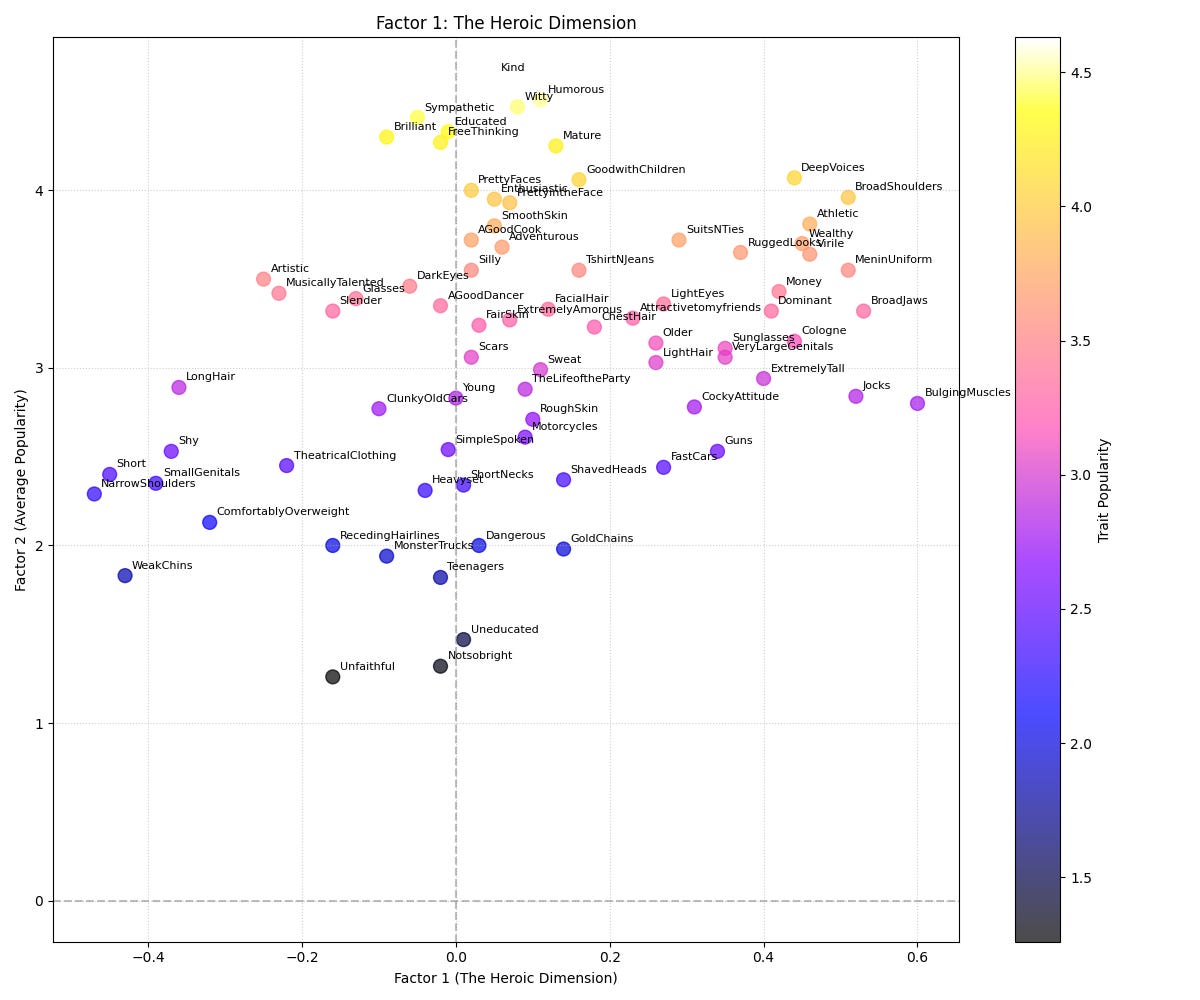
You may remember what I said last time about physical traits like height and penis size being third-tier, highly negotiable traits for most people who’re into men. While that is true in general, it’s not true for people at the right side of this dimension. And it’s even reversed for people at the extreme left side: if we look only at the five respondents at the extreme left, two standard deviations below average, we find three of the five actively preferred small genitals over large genitals, and four strongly desired a short man, while the others didn’t care. None of them wanted the traditional hunk. It’s the shy, slender creative types that make their hearts flutter.
The best single-item indicators for this dimension are bulging muscles and long hair. Both traits are similar in terms of their overall popularity, but according to these results, people who prefer one over the other are at opposite ends of the spectrum. It isn’t that either sort of person prizes long hair or bulging muscles above all else; if it helps, you can understand people at the right side of the spectrum by tilting your screen 45 degrees to the left—or further—and seeing how broad shoulders, deep voices, and athletic rise to the top. Turn it the other way to see what people at the left side are like, and traits like artistic and musically talented, and even narrow shoulders begin to surpass the usual popular traits brilliant, sympathetic and kind. But long hair and muscularity are among the strongest-loading traits on this dimension.
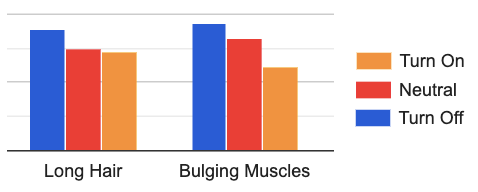
Although muscularity is wonderfully diagnostic for the heroic dimension, the desire for money, firearms, and uniforms should give a clue about the political aspect of this factor: it correlates with both conservatism (r = 0.29, p = 0.0000051) and tough-mindedness (r = 0.22, p = 0.0017). But whatever their political leanings, women who score high in this factor are not interested in pretty boys or starving musicians. If they aren’t looking for a man in finance, they dream of a strong, powerful man who can literally sweep them off their feet.
It’s worth pointing out that leftists often treat the dominant, virile, musclebound man as a male power fantasy, and like to analyze superhero comics through a critical or even hostile feminist lens. I wonder how these writers would react to the idea that this is a more compelling fantasy for many straight women and gay men than it is for heterosexual men. But moreover, I really have to ask—have none of them ever read romance novels? Have they never so much as passed by the covers at the checkout, or glanced at an add for Fifty Shades of Grey? The very tall, wealthy, powerful male is a staple of romance novels. And while obsessing over such men may not be typical, any more than it’s typical to quit your job to become a groupie for a long-haired starving musician, by my numbers here, either preference is still perfectly normal.
Factor 2: Pretty Boys vs Masculine Men
So I mentioned beards last time, suggesting people looking for love should seriously forget about them as something that doesn’t matter. If you’re trying to appeal to as many women (or gay men) as possible in order to maximize your chances, then this is absolutely true. But it’s also only half of the story, because some people absolutely adore masculine features like facial hair, along with chest hair, rugged looks, shaved heads, and scars, while others put a premium on smooth skin, pretty faces, slender bodies, and teenagers.
That’s right; though teenage boys are pretty unappealing to most people, those at the low side of the masculine dimension will at least spare them a look.
There’s been a lot of interest lately in the unsurprising finding that men mostly like women in their early twenties, while women mostly like men who are near their own age.6 I say the finding is unsurprising because it’s usually been a feature of marriage patterns for older men to marry younger women across the world and throughout history.7
Yes, I have seen some interesting economic arguments that explain this in terms of different income potentials for men and women, which cause young women to marry older men whose income potential has been revealed, even without their actually preferring older men.8 And it has been shown that as wage equality rises, so does the age at which women marry.9 It’s a general principle in science that we should prefer the simpler model over a more complex one, so I can understand why people might presume that the only reason young women ever go for older men is because they really want to know how much their partner will make, while straight men don’t care because they make plenty of money.
But growing up and living among human beings, it’s incredibly difficult not to notice the way women like older men. Search prefer younger guys and you’ll find a single, lonely Redditor asking Am I the only one who seems to prefer younger guys? Meanwhile, as Sean Connery was getting ready to keel over and die, Today wished him a happy birthday, saying “After 85 years, you're still one of Hollywood's most handsome and suave leading men.”
The gap in age preferences between men and women is one of the most robust findings of cross-cultural studies,10 ever since David Buss’s famous cross-cultural survey of 37 cultures, when a women’s ideal long-term mate was found on average to be 3.4 years older than herself.11 So maybe economists are able to explain why women prefer older men in terms of wage gaps, but speaking of wages in the broad sense, these gaps have been around for an awfully long time. Eventually evolution starts to notice, and that’s where we are today.
Yet obviously we can see by the results of this survey that not everyone likes older men. So what were the people in my sample looking for when they showed an interest in younger guys? It seems what people on the left side of this dimension like is pretty young men with fair skin, light eyes and light hair, and, interestingly, money. Since money is rarely found in the hands of actual, living, breathing pretty young men, it may be that these respondents are really wanting a handsome young prince, and aren’t worried about his talents as a protector or provider.
Meanwhile, on the other side, people are evidently looking for a lot of testosterone—virility, deep voices, and broad shoulders like the heroes of factor 1, but even more than this, plenty of hair on the face and chest (and they’ll even put up with a man who’s going bald).
But look at the picture factors 1 and 2 generate when you plot them against each other, and then rotate them just a bit counter clockwise, to get this:
Compare this to the graph I gave previously, on romantic preferences for women:
Are these two graphs the same? My expectation was that they would be, and personally, I see them as clear echoes of one another. There’s slender in the bottom left corners, dominant and extremely tall up from the center of each graph. Mature and Heaviset are up and to the right, comfortably overweight wanders a bit but stays to the right, athletic is up and to the left. Some of the psychological traits around the middle definitely travel, like unfaithful, artistic, and shy, but this is to be expected given the probability that this 2D slice is slightly rotated through any of the three other dimensions. The overall outline of all six clusters is recognizable to me: Youthfulness, beauty, athleticism, maturity, curves/fat, and then this weird void that would be childbearing in a woman.
But step into that void. Because to me this is the very most interesting thing to do: look at the center of the top map and imagine the average man. Then go down and slightly to the right, directly towards that void, and find muscles get smaller, the cocky attitude disappears, hair gets longer, chins get smaller, genitals get smaller. Don’t stop; keep going and going and going until bam you’re looking at a woman. This is the exact opposite process I said you could take from the bottom map to get from a woman to a man.
Men can’t bear children, so to make up for this there are other traits that the void draws in, like artistic and musical talent. But the dial that says, “I’m not into big dicks or bulging muscles. I like short people with long hair, uh… ‘weak’ chins, and small, tight genitals” is the dial you crank up to get a person attracted to a woman, in just the same way that those traits on the upper end of the other map, just leaning to the left, show the dial you crank up to get a person attracted to men: “I’m not into fertility, I like short hair, broad shoulders, yeah maybe narrow hips.”
I do want to stress that this is an obviously handwavey argument. These kinds of stories are really no substitute for better data from a cleaner design to test whether people attracted to men vs women really do have the same basic psychological machinery underlying their interests. The correct way to determine that interests are the same across people interested in men vs women is to carry out two surveys with identical content, and then see whether the PCA of one matches the PCA of the other. But on the basis of what you’re seeing here, do you think I have the right idea? Or am I just seeing things I expect to see? Let me know in the comments below.
Factor 3: Romantic Comedy
If the first factor of desire centers on the kind of men who dominate romance novels, the third factor centers on a suite of traits that, broadly speaking, make for a solid male lead in a romantic comedy:
This appears to be vaguely analogous to the Trad Wife dimension in the survey on women, with cooking and childrearing skills at the high end. As with the TradWife dimension, there weren’t many negatively loading items; evidently, respondents at the let end of the scale aren’t taken in by the goofy, talented protagonist.
Granted, not just any RomCom male protagonist will quite fit the bill, as there’s a certain flavor of eagerness and creativity here that we don’t always see in romantic comedies. Jack Nicholson is too cynical in As Good as it Gets, and Steve Carell is too clueless in Crazy, Stupid Love to fit the mold. Although he may never qualify as particularly pretty, the best example I can think of to exemplify the personality of the RomCom dimension is probably Bill Murray by the end of Groundhog Day.
In terms of personality, those who appreciate this kind of man tend to be emotional (r (r = 0.219, p = 0.0007) and in this sample, they leaned towards extraversion (r = 0.141, p = 0.03). As with the heroic dimension, interest in the rom-com dimension is also politically loaded, but in the opposite direction, with tender-minded leftists more drawn to the traits that make for a good male lead in a romantic comedy. (Conservatism: r = -.17, p = 0.0089; Tough-Mindedness: r = -0.13, p = 0.046).
Given the way both dimensions 1 & 3 show political loadings, it seemed obvious to see how they would look plotted against one another. Because the Heroic Dimension loaded slightly more on political values than the RomCom Dimension, I did some trigonometry and found I needed to rotate the plot 0.52 radians counterclockwise to arrange the graph so that right is right, and left is left:
When plotted this way, the factors seem to give a clear single dimension running left to right, with the vertical dimension mostly reflecting overall desirability. This may seem to capture the essence of political differences between leftists on the one hand who like enthusiastic artists who can dance and cook, and conservatives on the other hand who like athletes, soldiers, and business magnates. Evidently leftist women are looking for a fun date, and conservative women are looking for more of a protector and provider—and you may recall this is a mirror to the picture that emerged from the factors of attraction to women.
But there’s another aspect to political values that appeared in the responses; see if you can guess how politics relates to the next dimension.
Factor 4: Kind vs Dangerous
Across both surveys, the most popular trait was kind, and the most disliked trait was unfaithful. This factor turns that on its head; some people are willing to tolerate those who are unkind—and at the extreme end, they find red flags intriguing for the thrill of danger they provide.

This dimension is actually somewhat reminiscent of the Barbie dimension, saturated as it is with props and machinery: Sunglasses, guns, cars, monster trucks, sweat, theatrical clothing, scars, and gold chains all load positively on this factor. Again, many of these things are unpopular enough that what this really means is that most people high in factor 4 will generally just tolerate gold chains and monster trucks. But there was a small subset that did actually like even these things. And just as the Barbie Dimension seems saturated with the kind of content that easily lends itself to paraphilias, the Danger Dimension invokes the same idea that some people have a kind of block or inability to achieve sexual gratification without a jolt of something frightening or taboo to send them over the edge.
We’ve known for a long time that the parasympathetic nervous system—responsible for relaxation and digestion—is involved in arousal, but activation in the sympathetic nervous system, which gears us up for fight or flight, is necessary to achieve orgasm, and decreasing activity in the sympathetic nervous system inhibits sexual arousal.12
I mentioned Daniel Bergner, above. In his What Do Women Want, he mentioned an interview with a doctor who treated patients with paraphilias. The doctor talked about these men suffering from a kind of “sticky switch” controlling their parasympathetic and sympathetic nervous systems:
The natural progression during sex is that the parasympathetics are set off, and at some point when we become sufficiently aroused a switch flips and the sympathetics kick in and we start to have an orgasm. But the poor paraphilic has a sticky, sluggish switch and needs to do something extreme to get the sympathetics going.13
And well, if you look at the left side of the Danger Dimension, it’s hard to imagine someone kind and sympathetic, someone who is a good cook, doing the kind of thing that sets off the alarm bells of a person’s sympathetic nervous system.
But just what kind of people have so much trouble sexually that they need a dangerous man to satisfy them?
Well I gave you a clue when I compared this to the Barbie Dimension, because in my sample of people attracted to women, high scores on the Barbie Dimension correlated with conservatism. And in just the same way, leftists in this sample of people attracted to men aren’t as intrigued by danger as conservatives are (r = 0.236, p = 0.00025).
Yet having revealed that, I should also point out that danger doesn’t seem like an outlet for the staid, responsible conservatives of the world. Instead, the kind of person who responds to this is eccentric and even slightly unhinged, being low in Conscientiousness (r = -0.22, p = 0.0007), somewhat high in Openness (r = 0.18, p = 0.0055), and showing elevated psychosis proneness with high Disintegration (r = 0.20, p = 0.002). Gay and bisexual men show more interest in danger than women do (d = 0.57, p = 0.037), which made me wonder whether these assocations with personality or politics were somehow a manifestation of the gender difference. However, when I looked into this by restricting my analysis to female respondents, all the corelations remained unchanged.
Frankly, it should be no surprise that it’s a certain kind of woman who likes the bad boys. For years, Mrs. Pie and I have been exchanging eye rolls whenever the subject of game and being a redpilled alpha came up; so far as we could determine, game was a way of attracting the attention of the kind of women we couldn’t imagine anyone being interested in attracting. Put another way, we always thought the pickup artists were probably doing the world a favor by siphoning off the kind of women the rest of us know better than to get involved with.
Now, though, it does look like that kind of woman is actually pretty imaginative, at least. And maybe being able to appreciate the wild, untamed side of a man is a good thing, since men in general are more dangerous than women when it comes down to it.
Still, the recklessness of people at the extreme end of this dimension doesn’t do the world any favors—definitely not if it means that men being processed by our criminal justice system end up fathering yet more children for the same criminal justice system to cope with. If we wonder why in the world anyone in their right mind would send love letters to Ted Bundy, Joseph Fritzl or Dylan Roof, well, an extreme response to factor 4 is why: these people are exited by dangerous men.
Factor 5: Ditsy Teens vs Sophisticated Gentlemen
The fifth dimension pits older, mature, educated men against people who are probably most accurately described as ditsy young hillbillies:
These on the left side of factor 5 are not looking for quite the same young men as those from the left side of the Masculine dimension. The low pole of the Masculine dimension combined youth with wealth and beauty; in this case youth is more related to inexperience, immaturity, and boyish interests. The right side of the dimension combines urbanity with maturity, suggesting a suave older gentleman.
This pattern clearly echoes the second factor that showed up in the survey on attraction to women, although this time it also tapped into age and maturity. The average ratings along this dimension rise as we go from left to right, which indicates most people are well to the right side. But plenty of people have an interest in more humble men, to the point that they look with distaste towards age and education.
I should stress that no women in my sample (and only one man) indicated an actual liking for uneducated or unintelligent men. Rather, those at the very bottom end of this scale seem more skeptical of men who are educated and mature, with only the woman at the far left tail of this distribution showing a mild dislike towards those two traits. Meanwhile, those at the right side consistently gave high ratings to the popular traits.
Now the valuable thing about principal component analysis is that it gives dimensions. And dimensions can be rotated and flipped, just like turning a map or holding it up to a mirror. So while the Sophistocated dimension here may focus heavily on age and education, and the RomCom dimension may have seemed rather unique to people attracted to men, it turns out that if you rotate the space 45 degrees so that Sophistication combines with RomCom, you recover the same factor I called “Vapid Chicks vs Great Personalities” in the previous survey, and replicate two of the four personality correlates for the original factor.
This isn’t a proper confirmatory factor analysis, but there’s enough high-loading content shared across each dimension, and enough personality trait confirmations, to argue that this is a replication.
But I’ve already discussed the RomCom dimension for itself, so I want to discuss this factor I’m calling the Sophisticated Dimension on its own terms. The kind of people attracted to this picture of sophistication may have slightly elevated Extraversion (r = 0.138, p = 0.034) and Conscientiousness (r = 0.137, p = 0.035), and are much more likely to be female than they are to be gay or bisexual men (d = 1.2, p = 0.000002).
The clear relationships with respondent personality and gender shared by both this factor and the danger dimension also suggested something interesting might be found at the intersection of those two traits. So, I plotted both together below, rotated so that a liking for sophistication is oriented to the top-right, and a liking for danger is oriented to the bottom-right. (You’ll see why I chose this orientation in a moment.)
The personality signal of this combined vertical dimension is very clear: Extraversion, Agreeableness, and Conscientiousness all correlate positively (r’s from 0.173-0.271, p’s from 0.007-0.0001) and Disintegration correlates negatively (r = 0.221, p = 0.0006).
For the benefit of my general readers who aren’t that well-versed in psychology, I want to clarify something. These are all independent dimensions, but they’re also obviously valenced, in the sense that most people understand the three traits that go along with liking things at the upper end of the map are positive and healthy, while most people understand that Disintegration is pretty bad, since nobody wants to be prone to psychosis. So it really looks like the people in this survey on attraction to men, the people who are suspicious of the traits along the top of this map, are telling us that something is wrong.
I should stress that all of this is self-report. We don’t have any good observer ratings for the respondents in the survey to confirm what they’re really like. But it’s hard not to think of the distress voiced so clearly by people in abusive and dysfunctional relationships, people who ask, Is it me? Why am I attracted to jerks?
This is something that didn’t seem particularly striking in the survey results from people attracted to women. Yet it was always there, in terms of the same kinds of negative personality traits that related to disinterest towards kind, educated women. If some of this was missing from that survey, it was likely because I never included “dangerous” as a term that I thought people attracted to women would resonate with. I only included it in this survey on a whim: “People say women are attracted to dangerous men; I wonder if it’s true.” Now I know it isn’t true for most people, any more than it’s true that most people are turned off by education—but some people are turned off by education, and things don’t seem to be going very well for them.
I know, because in a sense, I used to be one of them.
As a young man, I had to be practically dragged, kicking and screaming, into the world of physics. I only enrolled because I wanted a job at the local college and they wouldn’t give me one unless I took classes. But I also dimly hoped I might be able to meet a smart girl if I chose a prestigous major; it seemed like statistically sound reasoning, and the longer I attended, the more likely this started to seem, until I ended up with a degree and a young Mrs. Apple Pie. But that was the end of a very difficult time in my life, and I’m frustrated by my dizzy and even downright ignorant instructors who taught me to hate school along the way. (For long time readers, I’m thinking about teachers like this guy.)
But this is my personal experience; it may not translate to other people. Falling back on that simpler, clumsier way of intuiting what people are like based on reading and experience, I suspect that with most of us the problem isn’t being alienated by the educational system so much as it is having a more straightforwardly strange attraction pattern. There was a lot of suspicion when I found the major dimension of attraction to women related to body weight, and I reported that a significant minority of people attracted to women are closeted chubby chasers, but that was what all the data was saying. So I’m now going to say a significant minority of heterosexual women and gay men are attracted to jerks, because that’s what the data is saying.
What should you do if this turns out to be you? I really don’t know, any more than I know what people should do if they’re gay, and really wish that they weren’t.
And ultimately the same lesson keeps appearing again and again: Life is hard. Relationships are absolutely fundamental to life as a human being, and relationships are difficult. We try our best, but most relationships before marriage dissolve, and so do a third of all marriages. Partly this is just another case of Americans’ culture being dysfunctional—our divorce rate is generally listed as around the 10th highest in the world—but in places like India where divorce rates are low, people have told me marriages are also often miserable.
Lots of people on Substack today are worried about the plummeting birthrate, but they rarely talk about the fact that children not only put a strain on relationships, but also force a greater dependence on those relationships, and make it more difficult to escape them when things go wrong. We spend so much time struggling to attract other people and form relationships to begin with, but how much time do we spend trying to figure out how to keep them healthy?
Take care of each other, everybody.
And to those of you who have nobody at all, good luck.
Three key takeaways for people who are unmoved by the suffering inherent in the human condition and just care about the numbers:
Most variation in attraction to men pertains to the degree to which people like long hair and creativity vs size, strength, wealth, and uniforms. To a modest degree, leftists like the former cluster of traits while conservatives prefer the latter.
Claims that “chicks like X” or “the ladies don’t like Y” are generally oversimplifications. Just as with attraction patterns to women, people attracted to men show a great deal of variation, and even unpopular traits like short stature or baldness are appealing to somebody.
Most people attracted to men, just like most people attracted to women, strongly value positive psychological traits like kindness and education. However, a few people who appear to suffer from minor personality problems indicate they are suspicious of maturity and education, and show an attraction to dangerous men.
Reynolds, T. A. (2022). Our grandmothers’ legacy: Challenges faced by female ancestors leave traces in modern women’s same-sex relationships. Archives of Sexual Behavior, 51(7), 3225-3256.
Ryan, C & Jetha, C (2012). Sex at Dawn: The Prehistoric Origins of Modern Sexuality. Harper Perennial.
Saxon, L (2012). Sex at Dusk: Lifting the Shiny Wrapping from Sex at Dawn. CreateSpace Independent Publishing Platform.
Lehmiller, J J (2023). Tell Me What You Want: The Science of Sexual Desire and How it Can Help You Improve Your Sex Life. Robinson.
Bergner, D (2013) What Do Women Want? Adventures in the Science of Female Desire. Ecco, An Imprint of HarperCollins Publishers, Open Road Integrated Media
Rudder, C. (2014). Dataclysm: Who we are (when we think no one's looking). Random House Canada.
Presser, H. B. (1975). Age differences between spouses: Trends, patterns, and social implications. American Behavioral Scientist, 19(2), 190-205.
Blavatskyy, P. (2018). Why do young women marry old men?. Theory and Decision, 85(3), 509-525.
Shephard, A. (2019). Marriage market dynamics, gender, and the age gap.
Conroy-Beam, D., & Buss, D. M. (2019). Why is age so important in human mating? Evolved age preferences and their influences on multiple mating behaviors. Evolutionary Behavioral Sciences, 13(2), 127.
Buss, D. M., Abbott, M., Angleitner, A., Asherian, A., Biaggio, A., Blanco-Villasenor, A., ... & Yang, K. S. (1990). International preferences in selecting mates: A study of 37 cultures. Journal of cross-cultural psychology, 21(1), 5-47.
Meston, C. M. (2000). Sympathetic nervous system activity and female sexual arousal. The American journal of cardiology, 86(2), 30-34.
Bergner, D (2013) What Do Women Want? Adventures in the Science of Female Desire. Ecco, An Imprint of HarperCollins Publishers, Open Road Integrated Media, p. 96.





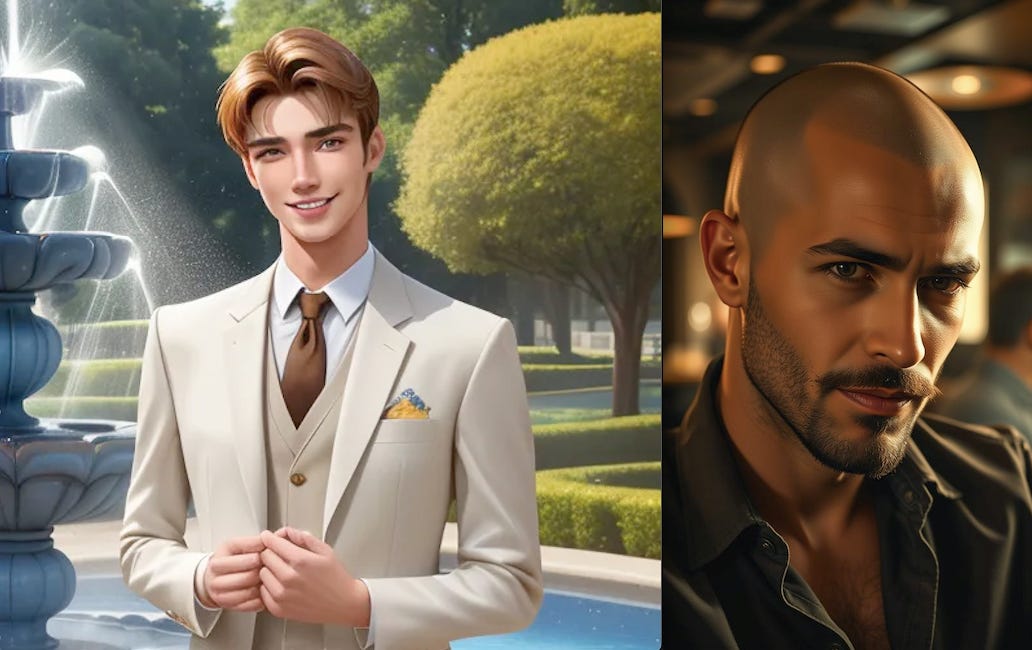
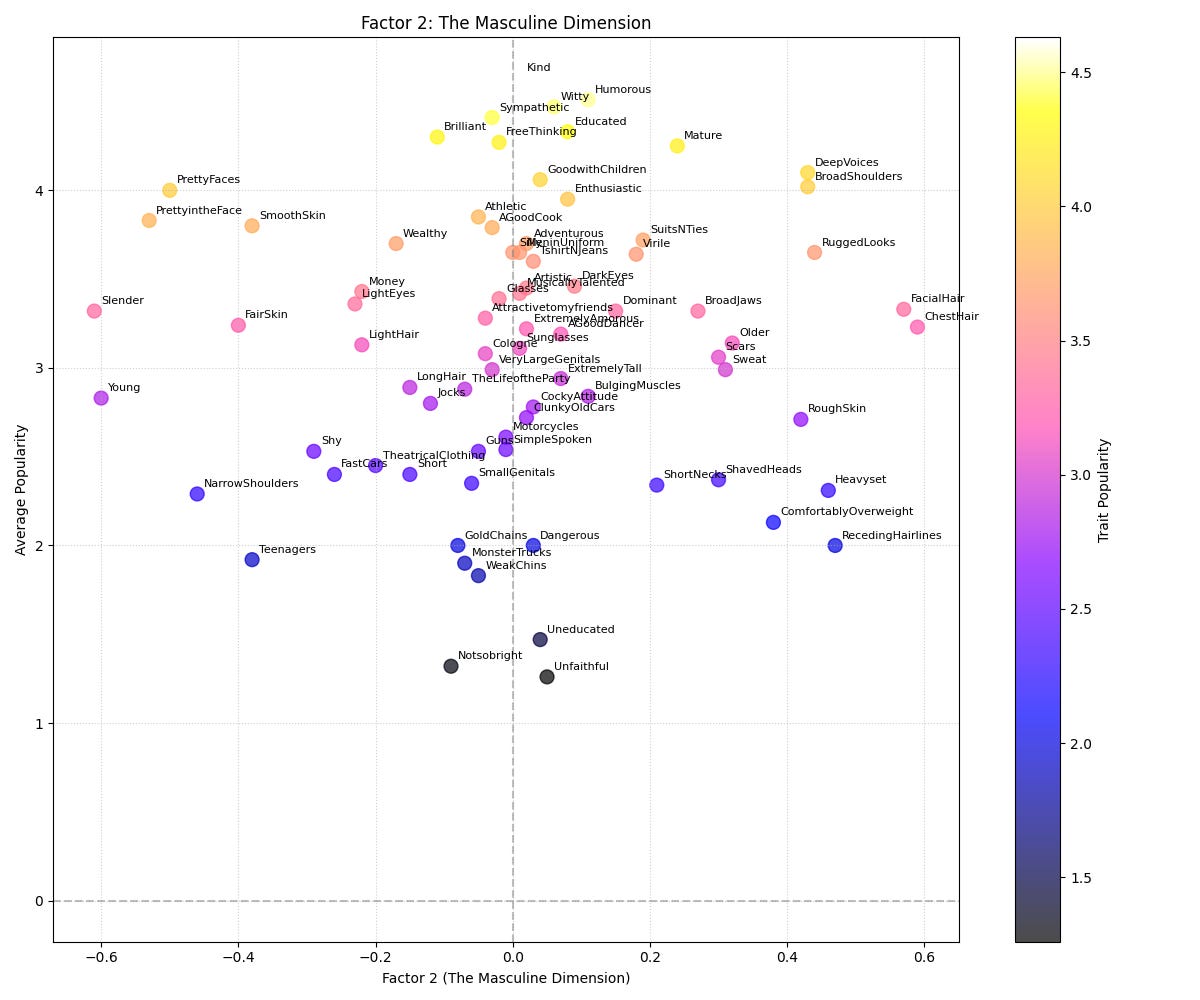
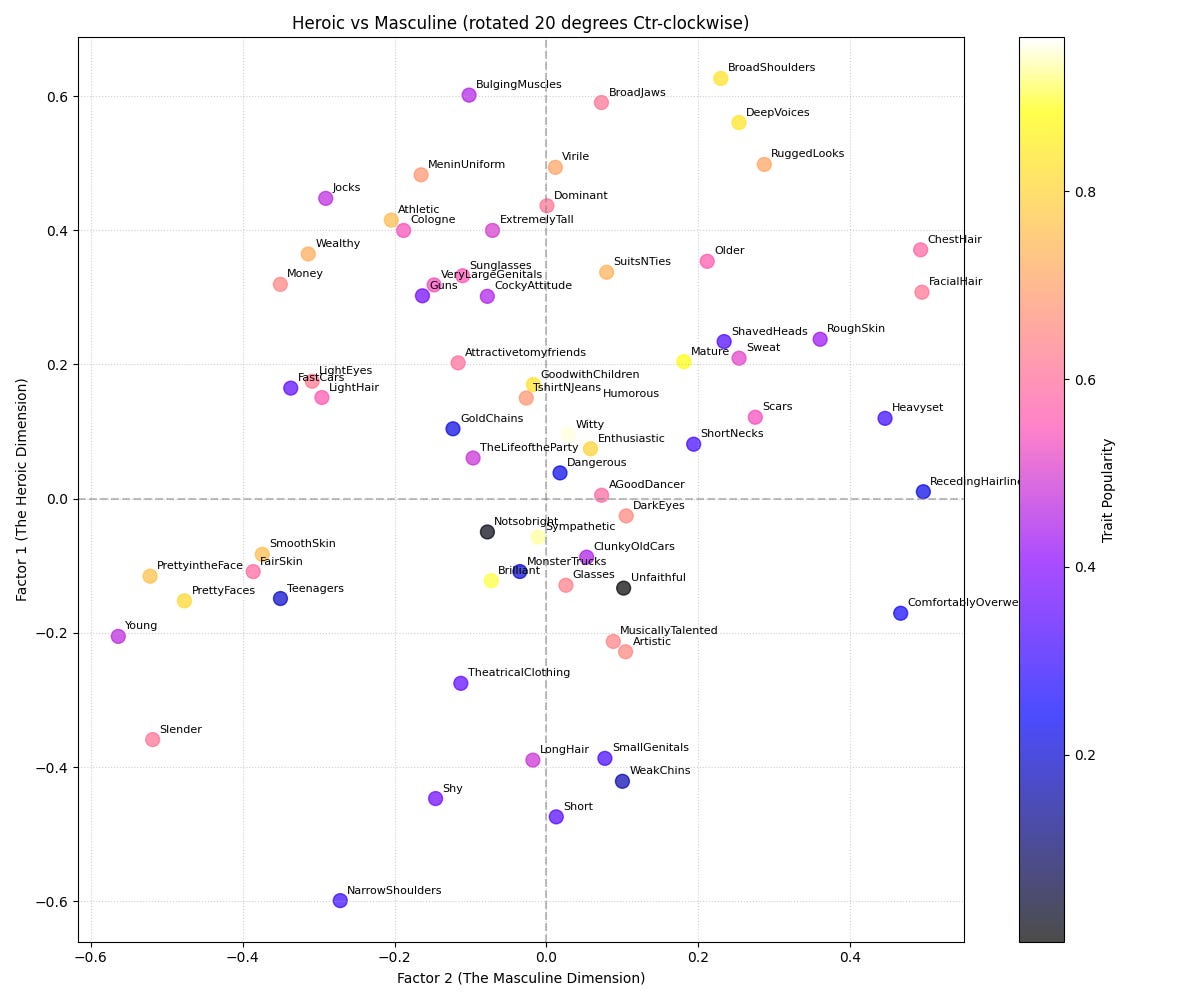

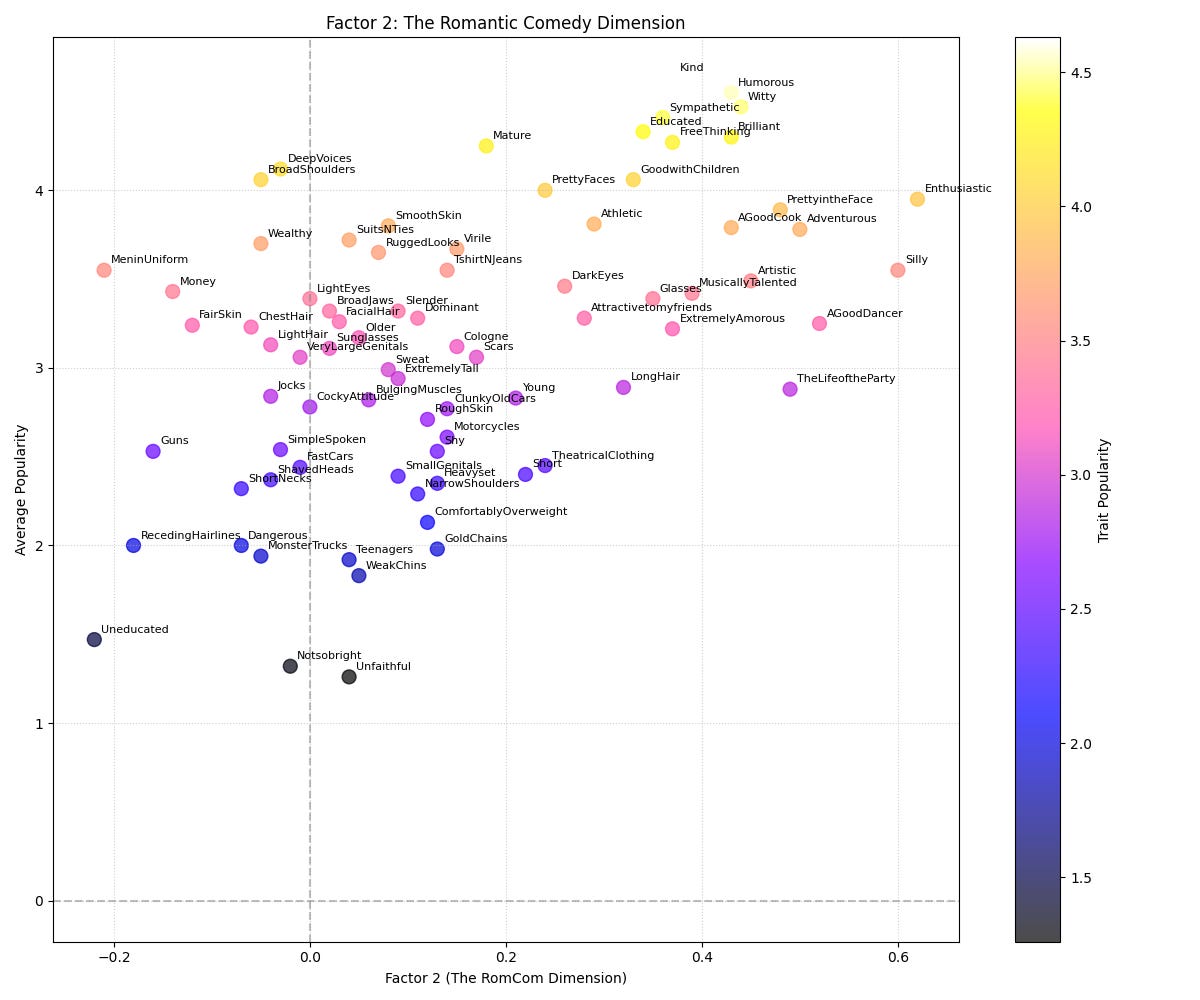

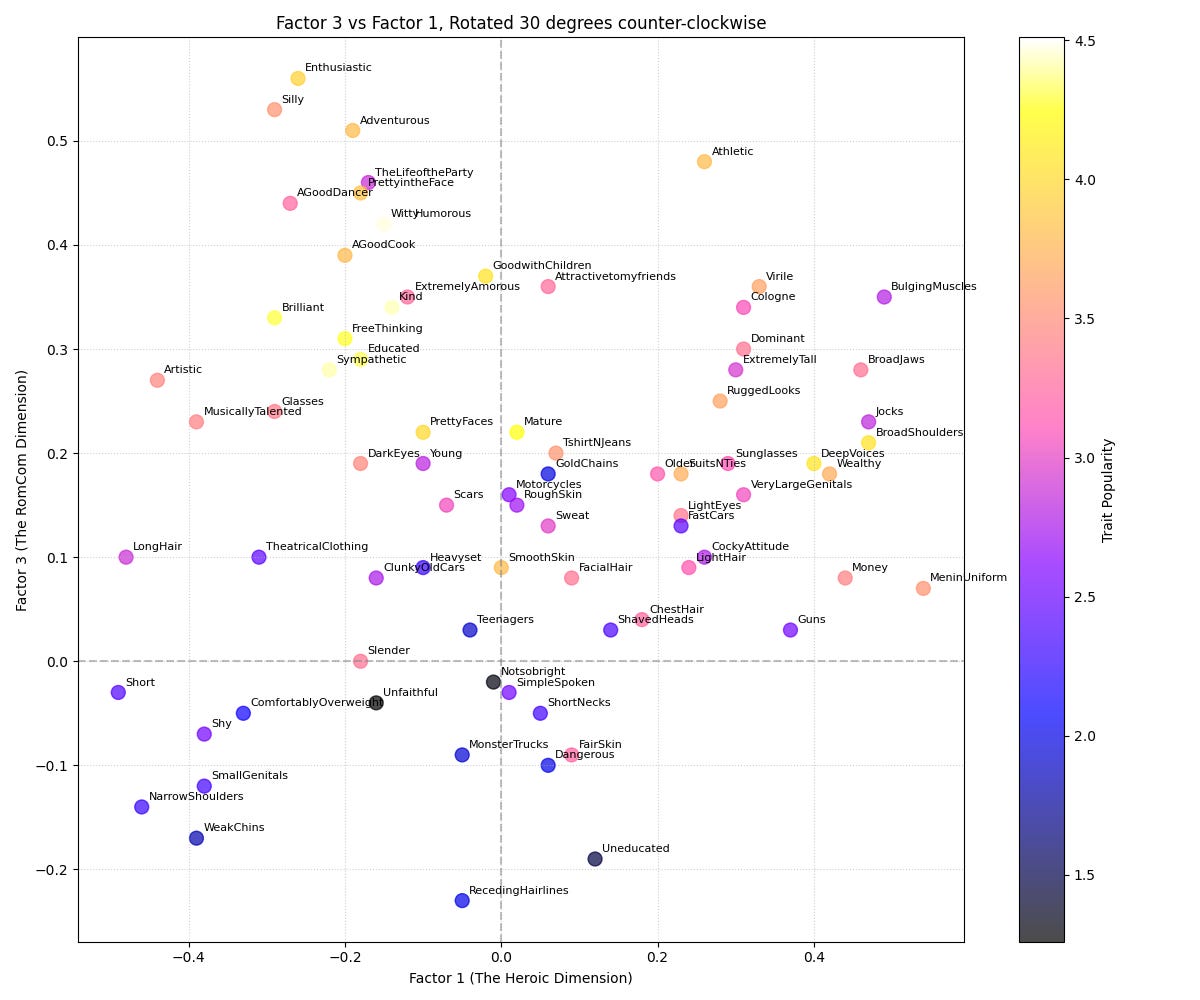
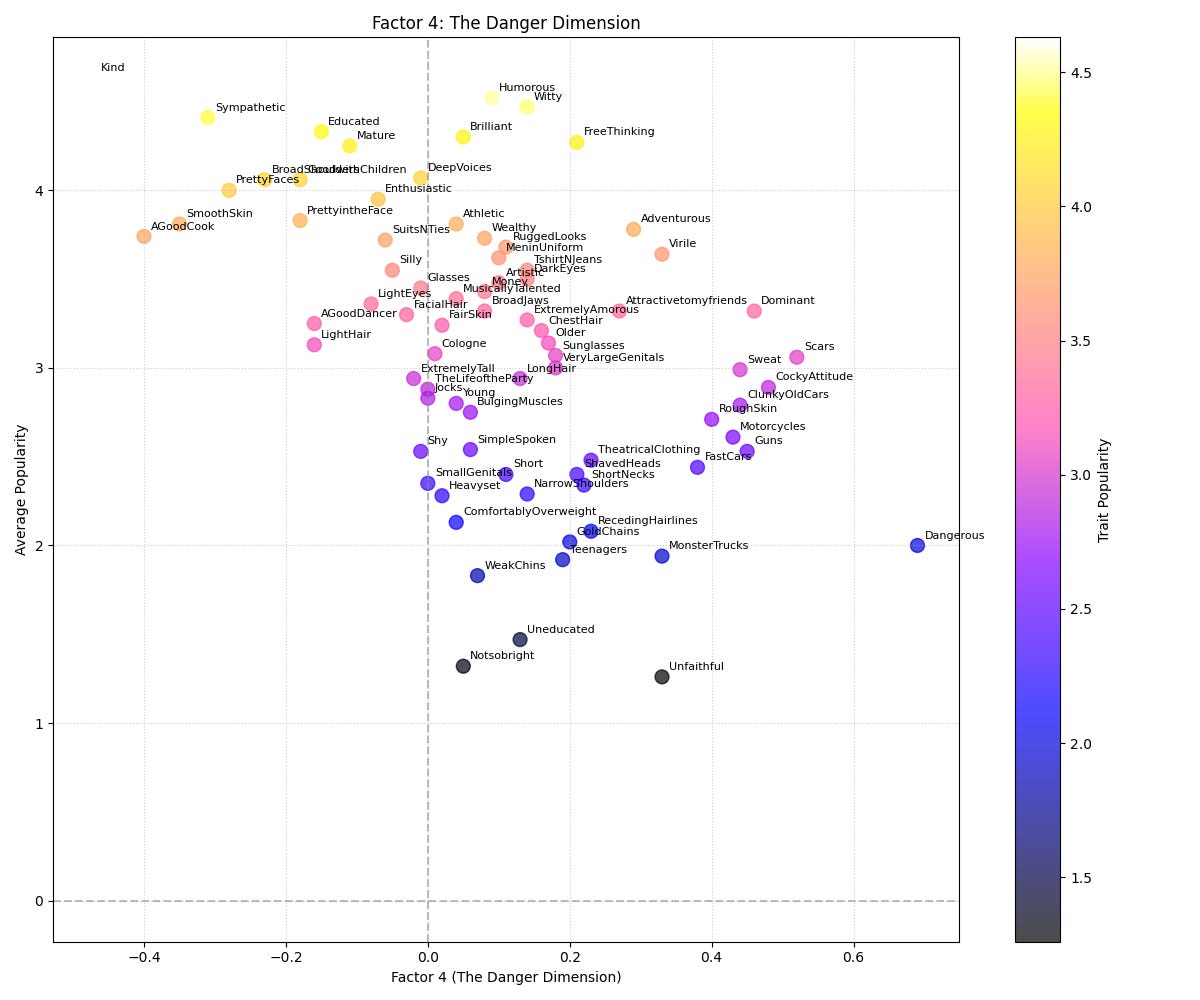
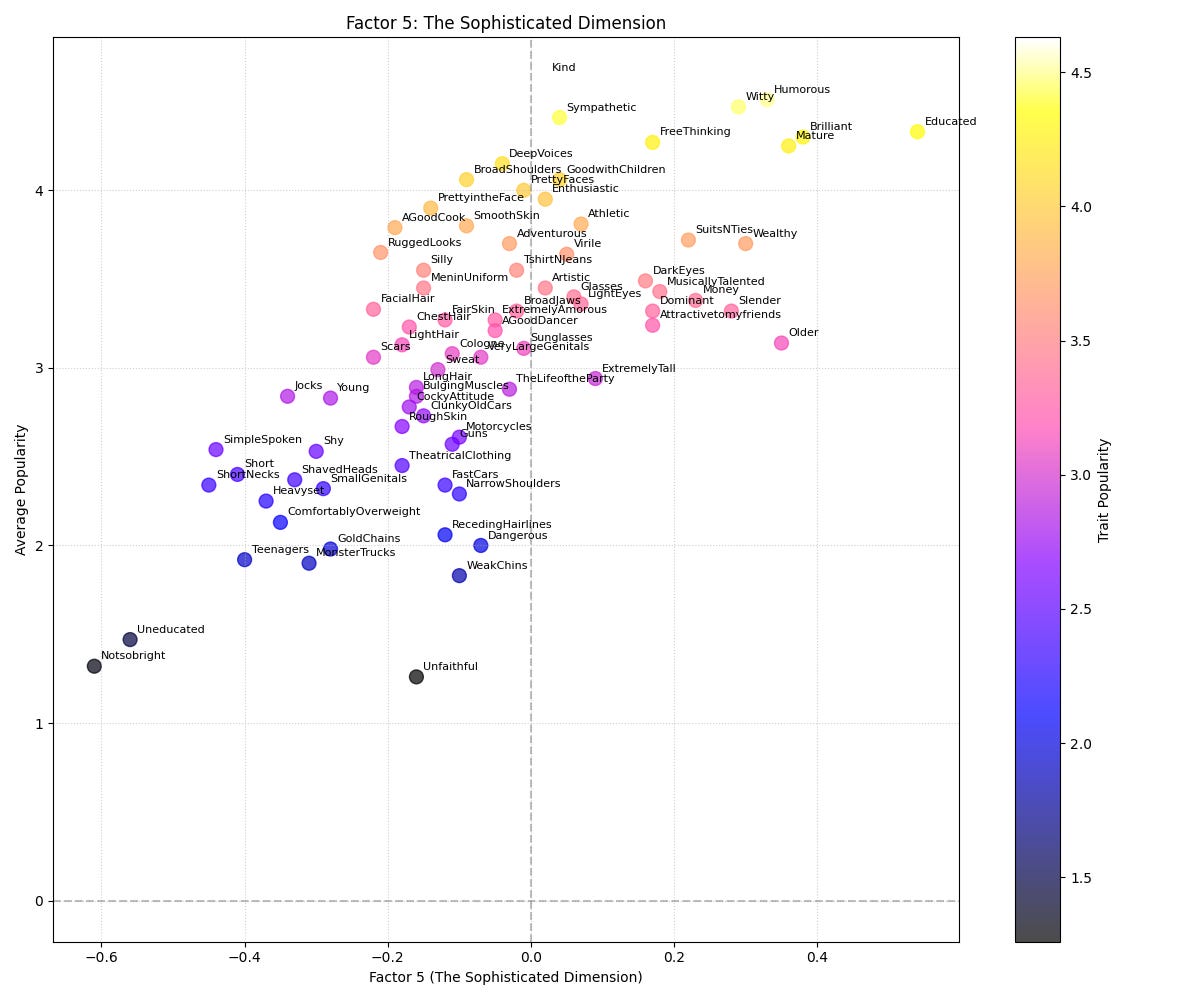

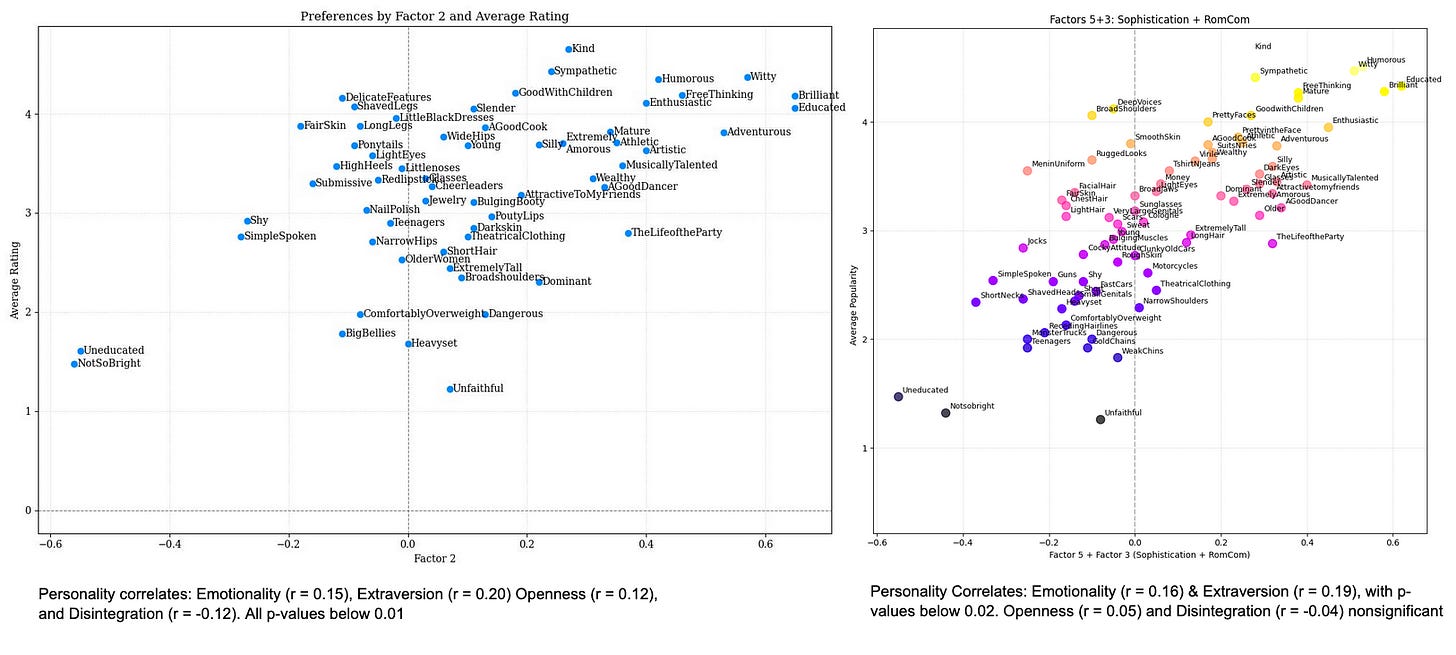
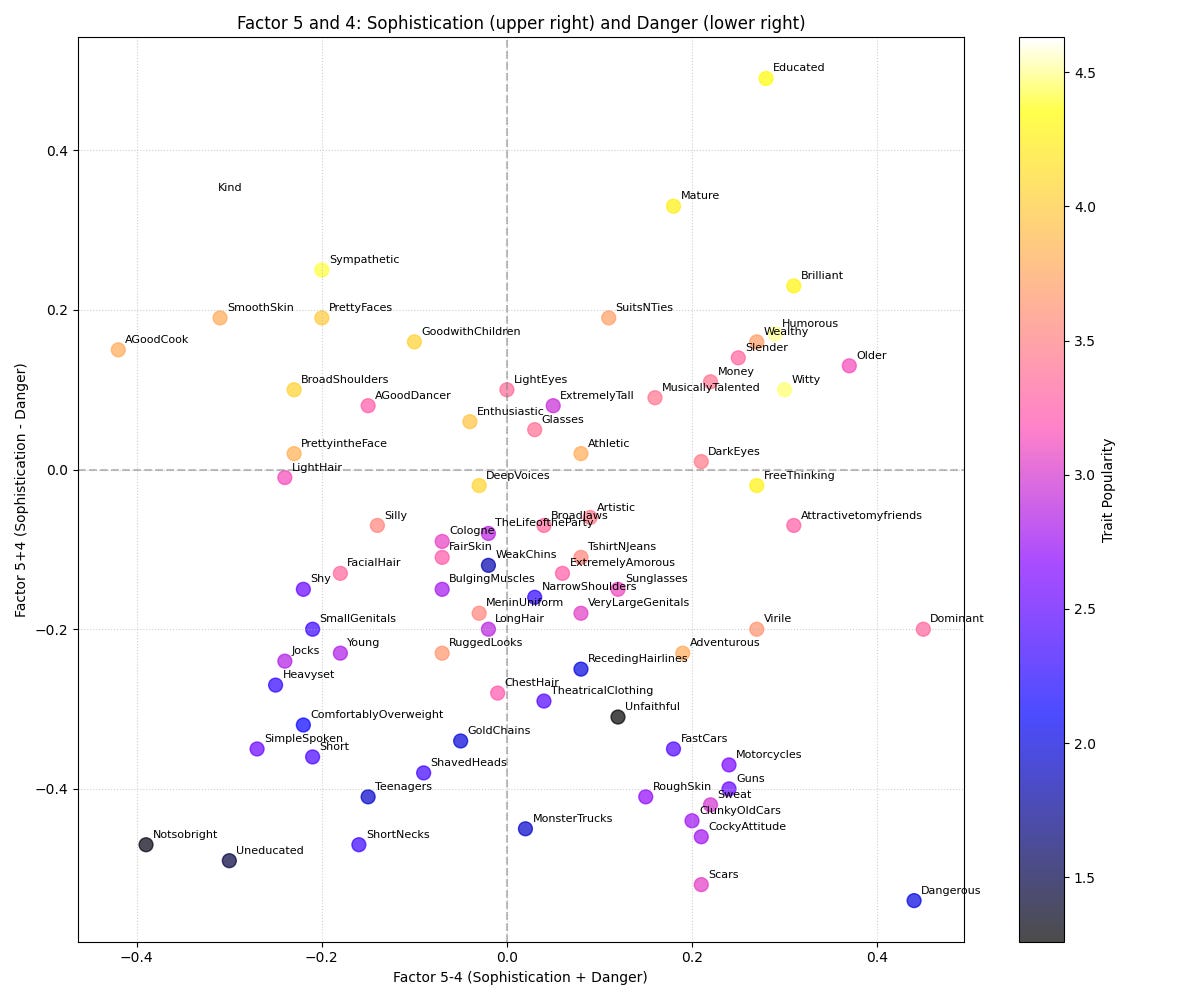
I'm not gifted enough with statistics to tell whether the pattern you see is relevant or not, but from a personal point of view I spontaneously felt like protesting a bit. As one of those women who are attracted predominantly to boyish men, I wouldn't guess that such an attraction pattern is an expression of closet lesbianism or even something close to that. Because (like most women, I guess) I'm also attracted to women. I have never acted in any way on my admiration for beautiful women and will never do so because I'm a demisexual. Nonetheless, in particular when I was younger I had a very particular taste for women. The girls and women I found attractive were all a bit on the heavier side, that is, not boyish at all. So from my very narrow perspective of introspection, I don't have the impression that attraction to men that are not maximally manly is somewhere on the scale toward attraction to women.
And yes, once upon a time I was electrified by What do Women Want by Daniel Bergner. It is a great introduction to the weirdness of female sexuality. But after having gotten used to the thought it is time to move on.
I'm growing my hair long and am hitting the gym to get ever more muscular. Therefore.... ALL THE GIRLS LOVE ME!